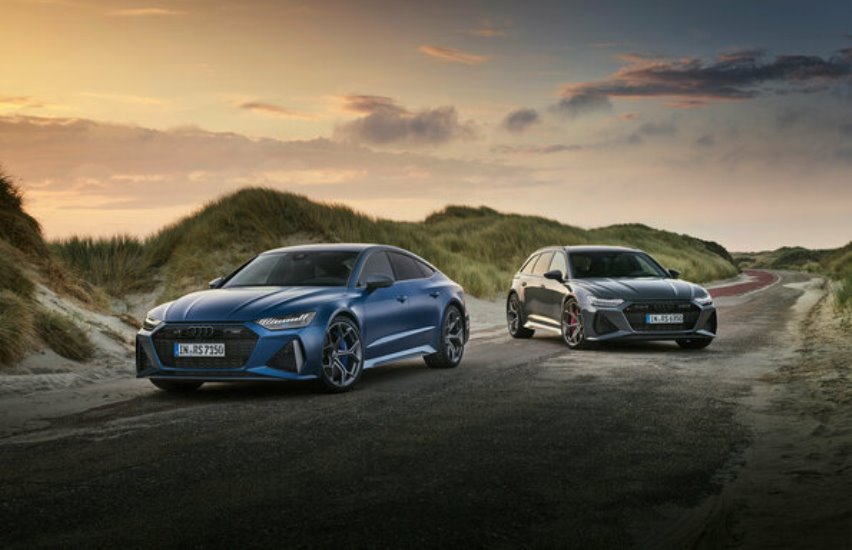
More powerful and faster than any RS 61 and RS 72 to date: new Audi RS 6 Avant performance1 and the RS 7 Sportback performance2 are bursting with extras that sharpen the models’ appearance and make for a more emotive driving experience. The potent 4.0-liter V8 biturbo TFSI engine now has an engine power of 463 kW (630 PS) and a maximum torque of 850 Nm3. From December 8, the RS 6 Avant performance1 and the RS 7 Sportback performance2 are available for 135,000 euros each.
Yet less is sometimes more: reduced insulation between the engine compartment, the interior, and the rear of the vehicle ensures the RS 6 Avant performance1 and the RS 7 Sportback performance2 will thrill customers with an exciting, next-level sound experience – the reduction also makes the car eight kilograms lighter. The RS 6 Avant performance1 has a total unladen weight of 2,090 kg whilst the RS 7 Sportback performance2 weighs 2,065 kg.
For heightened driving dynamics: new self-locking center differential
Power from the 4.0 TFSI engine flows through a standard eight-speed tiptronic with faster shifting times to the permanent all-wheel drive quattro. The strictly mechanical center differential distributes engine power to the rear axle at ratio of 40:60 and if slippage occurs, more drive torque is automatically applied to the axle with better traction – up to 70 percent can flow to the front axle and up to 85 percent to the rear axle.
The self-locking center differential is lighter and more compact, improving driving dynamics plus offering noticeably more precise cornering which makes for less understeering at the handling limits. As an added improvement, the self-steering response is more exact with passengers benefitting from a more agile driving experience overall.
Exclusive and high-performance: 22-inch wheels with high-performance tires
The new RS 6 Avant performance1 and RS 7 Sportback performance2 roll off the line on standard 21-inch aluminum cast wheels in a ten-spoke star design and 273/35 tires. For an even sportier appearance, 22-inch lightweight wheels are also available, alongside the standard 22-inch aluminum cast wheels – in burnished glossy metallic black, matte gray, matte black, or matte neodymium gold.
Inspired by motorsport, the airy 5-Y spoke design aids brake cooling and the lighter rims are manufactured in a high-tech forging-milling process. The new lightweight wheel is around five kilograms lighter than the 22-inch aluminum wheel on the current RS 6 Avant or RS 7 Sportback – this 20-kilogram weight reduction in unsprung masses improves the throttle response.
New high-performance Continental “Sport Contact 7” 285/30 tires, which are part of the new lightweight wheel, play a key role in reducing weight. The tires offer consistently better grip on both dry and wet roads and reduce understeering when cornering at speed, making for overall more precise handling across the entire speed range. Additionally, the brake path is up to two meters shorter with the new wheels when braking from 100 to 0 km/h.
The Audi drive select dynamic handling system lets the driver control the vehicle’s character. Six profiles are available: efficiency, comfort, auto, dynamic, as well as two customizable RS-specific RS1 and RS2 modes.
But experience of the driving modes in the performance models is much more unique. For example, the coasting mode now only activates automatically in the efficiency profile, which means in speed ranges up to 160 km/h, it switches off the combustion engine and coasts with no fuel consumption or drag torque from the engine.
Additionally, fine-tuning to the engine control unit software makes for tighter load changes in S mode when the “dynamic” drive select mode or driving mode S is active, further increasing the emotionality. The updated software in the transmission control unit makes for faster shifting times and a noticeably increased spread between the various driving modes.
RS Dynamic Package as standard
The RS Dynamic Package is standard equipment in the RS 6 Avant performance1 and RS 7 performance2 models. This includes the increase in maximum speed to 280 km/h (180 mph), dynamic all-wheel steering (the RS-specific software update helps the driver with active steering corrections on the front and rear axles), and the quattro sport differential on the rear axle.
The RS Dynamics Package plus is also available as an option, which in addition to the RS Dynamics Package, raises the top speed to 305 km/h and includes an RS ceramic brake system. Customers can order the calipers in gray, red, or blue and discs measure 440 mm (front) and 370 mm (rear). The RS ceramic brake system weights a total of approx. 34 kg less than its steel counterpart for a reduction of the unsprung masses.
Fresh exterior colors and optics packages
The new RS 6 Avant performance1 and RS 7 Sportback performance2 are available in a total of 16 exterior colors – for the first time, metallic and matte Ascari Blue and matte Dew Silver are included.The performance models stand out with standard RS exterior components in matte gray, including the exterior mirrors, the front spoiler, the front side flaps, the side sill inserts, the roof rails, and the trim on the side windows and rear diffuser. A matte carbon/black optics package is also an option, in which the roof rails and trim on the side windows are black. The Audi rings and model name is available in the customer’s choice of chrome or black.
Out of the blue: new interior accents and features
In the interior, the familiar RS design packages in gray and red have been expanded to include the color blue. The steering wheel rim in Alcantra black features contrasting stitching in Mercato blue, whilst the floor mats, the side of the center console, and the selector lever cuff also come with blue contrasting stitching.
The seat belts are full-surface ocean blue with the decorative inlays in a carbon twill structure with optional blue accents. The selector lever knob and the side of the center console are made with Dinamica microfiber, which consists of around 45% recycled PET fibers and the sports seats feature high-quality Valcona leather upholstery perforated with honeycomb stitching with contrasting stitching in Mercato blue. Another distinguishing feature is an entrance LED in the front doors that projects the lettering “RS performance” onto the ground next to the car.
Customers can order RS design packages in the three available color variants with optional additional features: decorative inlays, door armrests and center armrest in Dinamica microfiber. An added benefit of this equipment variant is the seat center panel with a gray, red, or blue inlay, whilst the customer’s chosen color shows through the perforated sports seats and the seat backs feature RS embossing in matching colors.
Customers can use the new “Audi Exclusive Customizer” visualization tool to design their vehicles in thousands of individual combinations and thus create their own personal special edition. They can choose from a wide range of individual paint finishes as well as leather and stitching colors; the tool uses a 3D model to visualize the customization process. Check out the configurator here.
The displays of the standard 12.3-inch Audi virtual cockpit plus offer new features including a blinking shift indicator in manual transmission mode which changes the rpm display from green to yellow to red, blinking in a manner identical to that used in motorsport, to indicate the optimal time to change gears. Plus, Launch Control, which fully exploits the acceleration potential of the RS 6 Avant performance1 and the RS 7 Sportback performance2 by signaling the ideal moment to accelerate off the line, with new traffic light icons.
Performance by tradition: from the RS 6 Avant plus to today
The RS 6 Avant performance1 and RS 7 Sportback performance2 in the C8 generation continue Audi’s long-standing sport strategy of plus and performance models. It all began with the RS 6 Avant plus in the C5 generation, shortly before the series was discontinued in 2004, quattro GmbH (now Audi Sport GmbH) launched a special limited series of 999 units with a subtle upgrade in power.
The engine power climbed by 30 PS to 480 PS and the model bore the distinction of being the first Audi to officially go faster than 250 km/h. Audi Sport throttled the RS 6 plus to 280 km/h, making it the fastest sport wagon. Without the engine control unit, it reached a top speed of more than 300 km/h.
The plus variant in the C6 generation hit the market in 2008 and was limited to 500 units. Unlike its predecessor, it did not feature any additional power; the V10 kept its 580 PS. But Audi limited the top speed of the special Avant and Sedan to 303 km/h; the only faster vehicle at the time was the R8.
In the C7 generation, “plus” became “performance” – the Audi RS 6 Avant and RS 7 Sportback performance rolled off the line in 2016, with a slightly tweaked engine, the power rose to 605 PS, 45 PS more than in the base model. The overboost function increased briefly to 750 Nm in “dynamic” driving mode and depending on equipment, the speed was limited at 250, 280 or 305 km/h.

































